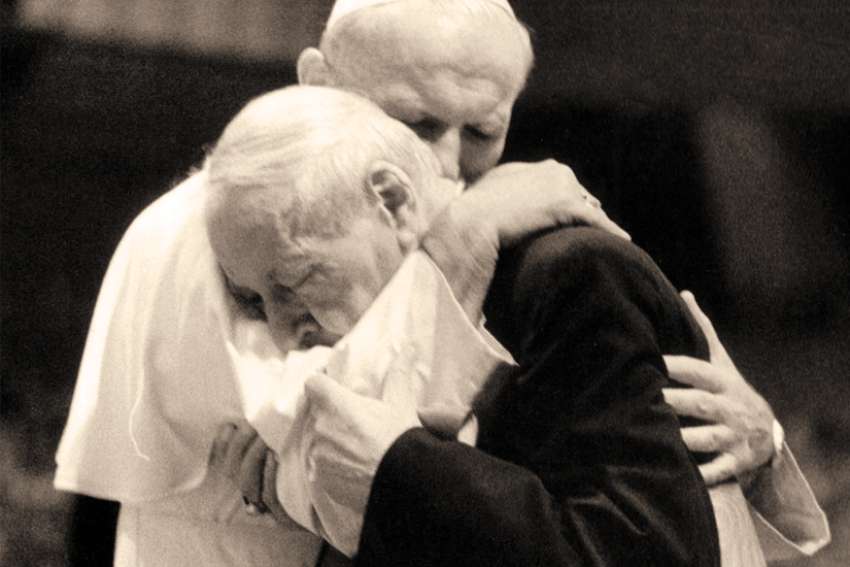Forty years ago this May, the most outstanding churchman of the 20th-century sent an envoy to the second most outstanding churchman of the century.
The latter, Cardinal Wyszynski was dying. After 33 years of fighting the communist regime, the courageous prelate and brilliant strategist was in the final stages of abdominal cancer.
St. John Paul II could not go to the Warsaw bedside of the great “Primate of the Millennium,” so he sent his personal secretary, Msgr. Stanisław Dziwisz, to visit him on 11th-12th May 1981. Msgr. Dziwisz then returned to Rome.
The next day John Paul was shot in St. Peter’s Square. Msgr. Dziwisz would be at the bedside of another man fighting for his life.
By May 25, John Paul was weak but recovering and Wyszynski was approaching his death agony. They would speak for the final time that day, having been unsuccessful the day before. In the days before cordless and mobile phones, at first they did not have long enough telephone cables to reach the beds.
The dying cardinal, in great pain and only able to speak in short gasps, asked the recovering pope for his blessing. Wyszynski would die three days later. When his funeral was celebrated in Warsaw, John Paul sent a message, and celebrated Mass in hospital at the same time as the funeral in Poland.
Cardinal Karol Wojtyła was, until 1978, very much the junior figure to the heroic cardinal. At the conclaves of 1978, the media was fascinated by the cardinal from Kraków who liked to go skiing.
“It’s not unusual in Poland,” Wojtyła said. “In Poland, 40 per cent of the cardinals ski.”
When reporters pointed out that there were only two cardinals in Poland, Wojtyła explained. “In Poland, Wyszynski counts for 60 per cent.”
The post-war Polish Church lived in the heart of her primate, Cardinal Wyszynski, who presided over the massive celebrations for the millennium of Poland’s baptism, 966-1966. The celebrations made clear that communism was an alien and unwelcome presence in a faithfully Catholic nation. The millennium was Poland’s true identity, and the Primate of the Millennium was her true leader.
At John Paul’s inaugural Mass, the cardinals processed in order of seniority to kneel before the new pope and kiss his ring. When Wyszynski approached — out of order, given the honour of coming immediately after the dean of the college — John Paul rose to embrace him before he could kneel. Wyszynski insisted on kneeling and kissing the papal ring; John Paul gripped him tightly, kissed his head, his face, his hand. In that moment, the millennial history of Catholic Poland was given as a gift from the Primate to the universal Church.
It was from Wyszynski that Wojtyła learned about anniversaries and mass gatherings and popular pilgrimages, all of which would bear fruit in the World Youth Days and the Great Jubilee of the Year 2000.
It was Cardinal Wyszynski, who in the conclave of October 1978, revealed to Cardinal Wojtyła his mission.
“Cardinal Wyszynski said to me: ‘If the Lord has called you, you must take the Church into the third millennium!’ ” John Paul revealed in 1994. The Primate of the Polish Millennium had formed the Pope of the Third Millennium.
“I understood then, that I must take the Church of Christ into the third millennium with prayer and with different initiatives. However, I realized that this wasn’t enough. She had to be introduced with suffering, with the attack. The Pope had to be attacked, he had to suffer so that every family, so that the world, would see that there is, so to speak, a higher Gospel, the Gospel of suffering.”
That was how John Paul understood the assassination attempt of May 1981 which threatened to cut short the mission Cardinal Wyszynski had revealed to him.
John Paul attributed his miraculous survival to the protection of Our Lady of Fatima, whose feast day falls on May 13, the date of the shooting. As a recognition of that protection the Holy Father gave one of the bullets which struck him to the bishop of Fatima; the bishop had it installed in the crown of Our Lady’s statue.
John Paul made no foreign trips during the Jubilee Year 2000 other than to the biblical lands. Except for Fatima. He went there for the feast day, the 19th anniversary of the assassination attempt. Immediately upon arriving in Fatima on the night of May 12, 2000, he presented the statue of Our Lady of Fatima with a gift. It was the ring that Cardinal Wyszynski had given to him upon his election as pope in 1978.
He had completed the mission prophesied by the great Polish primate. He survived in order to do so because of the intercession of Our Lady of Fatima. If he had vanquished Soviet communism along the way and liberated his homeland, that too was because of the maternal protection shown on the Fatima feast day in 1981.
St. John Paul and soon-to-be Blessed Stefan Wyszynski will share the honours of the altar, even as they went up to the altar together in life and, 40 years ago, remained united together at the threshold of death.
(Fr. de Souza is editor-in-chief of Convivium.ca and a pastor in the Archdiocese of Kingston.)

